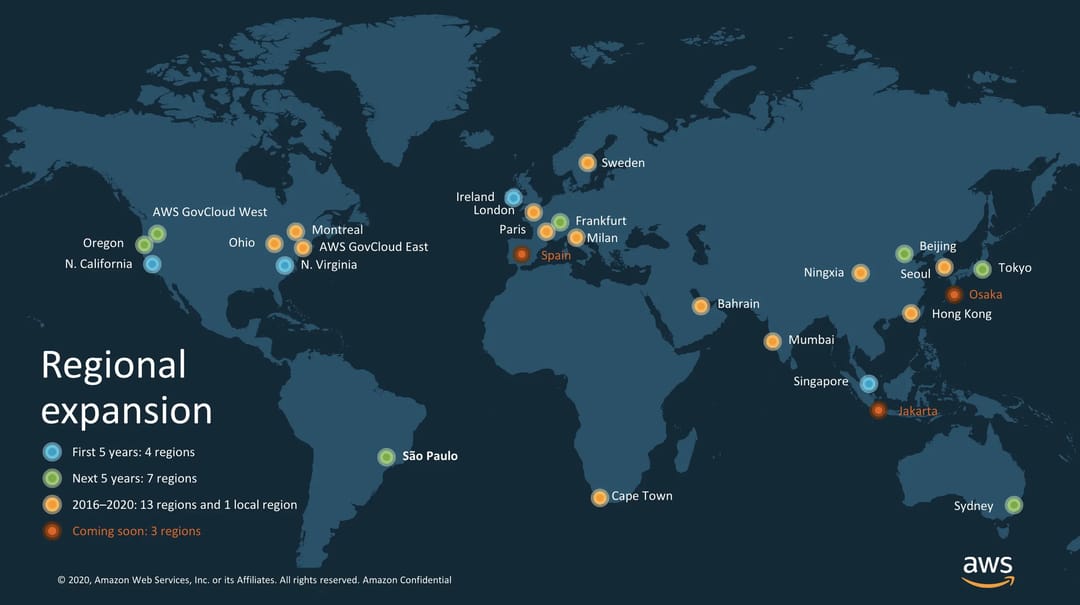Region
An AWS Region represents a physically isolated segment of the AWS cloud infrastructure, typically covering a broad geographic area. Amazon Web Services (AWS) operates a global network, currently encompassing 31 geographic regions spread across continents including North America, South America, Europe, the Middle East, Africa, and Asia Pacific. Understanding Regions is crucial because each one functions as an independent entity within the AWS ecosystem. They possess separate hardware, distinct networks, and operate autonomously from one another. Data replication between regions does not occur automatically; it must be explicitly configured by the user. This inherent separation provides significant advantages for building redundant systems and implementing effective disaster recovery strategies, offering resilience even if one region experiences an outage. Companies like Airbnb utilize multiple AWS Regions, combined with load balancing and auto-scaling, to ensure high availability for their global user base, maintaining service even during regional failures. Similarly, Slack leverages AWS Regions for storing user data and managing real-time messaging worldwide, ensuring both scalability and data locality.
Choosing the Right Region
Selecting the appropriate AWS Region involves considering several critical factors beyond simply using the default option.
-
Latency: Proximity to end-users is paramount. Choosing a region geographically closer to your user base minimizes delay and improves application responsiveness.
-
Regulations: Data sovereignty and compliance requirements, such as GDPR or local data residency laws, can dictate which region(s) you are permitted to use.
-
Services: Not all AWS services are available in every region. It's essential to verify that the specific services required by your application are offered in the chosen region.
-
Cost: Pricing for AWS services can vary between regions due to factors like local taxes, power costs, and supply chain logistics. Utilizing tools like the AWS Pricing Calculator helps estimate and compare costs.
While multi-region architectures offer the highest level of redundancy, a well-designed single-region deployment utilizing multiple Availability Zones often provides sufficient high availability for many applications, unless global-scale mission-critical operation is a strict requirement.
Availability Zone
Within each AWS Region, the infrastructure is further divided into Availability Zones (AZs). An AZ consists of one or more discrete data centers, each equipped with independent power, cooling, and physical security. These data centers are physically isolated from each other within the region—often separated by many kilometers—but are interconnected by high-bandwidth, low-latency, redundant fiber optic networks. This design ensures that a failure in one AZ (due to events like fires, floods, or power outages) is unlikely to affect others within the same region, providing a foundation for high availability and fault tolerance. For example, the us-east-1 region in North Virginia has at least six distinct AZs (us-east-1a through us-east-1f), each representing a robust, isolated data center facility. Netflix exemplifies the use of AZs by distributing its workloads across multiple zones using AWS load balancing and auto-scaling. This strategy ensures continuous streaming service for users even if one AZ becomes unavailable.
Best Practices for Using AZs
To effectively leverage Availability Zones for high availability and resilience, consider these practices:
-
Distribute Resources: Deploy application components and resources across a minimum of two Availability Zones within a region. This prevents a single point of failure at the AZ level.
-
Implement Backup and Failover: Establish robust backup plans and automated failover mechanisms. In case of an AZ failure, traffic should automatically redirect to healthy instances in other AZs.
-
Utilize Load Balancing: Employ services like AWS Elastic Load Balancing (ELB) to distribute incoming application traffic across targets (like EC2 instances) located in different Availability Zones. This enhances fault tolerance and ensures even workload distribution.
Edge Locations
While Regions and Availability Zones provide the core infrastructure for resilience and availability, AWS Edge Locations focus on delivering content and services with minimal latency to end-users globally. These are smaller infrastructure sites, strategically positioned closer to population centers than full AWS Regions. Their primary function often involves caching content, particularly high-bandwidth data like video, images, and scripts, to reduce the distance it needs to travel to reach the user. AWS CloudFront, Amazon's Content Delivery Network (CDN), heavily utilizes Edge Locations to cache static content for fast and reliable delivery. Other services operating at the edge include Amazon Route 53 for DNS routing, AWS Shield and AWS WAF for security protection, and even AWS Lambda via Lambda@Edge, allowing serverless code execution closer to the user. Twitch leverages CloudFront and other edge services to deliver low-latency live streaming video globally. Peloton also uses Edge Locations to stream high-quality, buffer-free workout videos to its fitness equipment and apps. It's important to note that not all AWS services are available at every Edge Location, and while they offer performance benefits, they can sometimes be more expensive than using resources within a traditional Region. Security considerations also differ due to their proximity to end-users.
Q&A
What is the main difference between an AWS Region and an Availability Zone?
An AWS Region is a large, distinct geographic area containing multiple data centers. An Availability Zone (AZ) is one or more discrete data centers within a Region, featuring independent power, cooling, and networking, designed for fault isolation. Regions provide geographic separation and service scope, while AZs within a region provide high availability and fault tolerance.
What is the primary purpose of AWS Edge Locations?
The primary purpose of AWS Edge Locations is to reduce latency and improve performance for end-users by caching content closer to them. They are key components of services like Amazon CloudFront (CDN) for faster delivery of static and dynamic content.
What factors should be considered when choosing an AWS Region?
Key factors include latency (proximity to users), regulatory compliance (like GDPR or data residency laws), the availability of specific AWS services needed for the application, and the cost variations between different regions.

